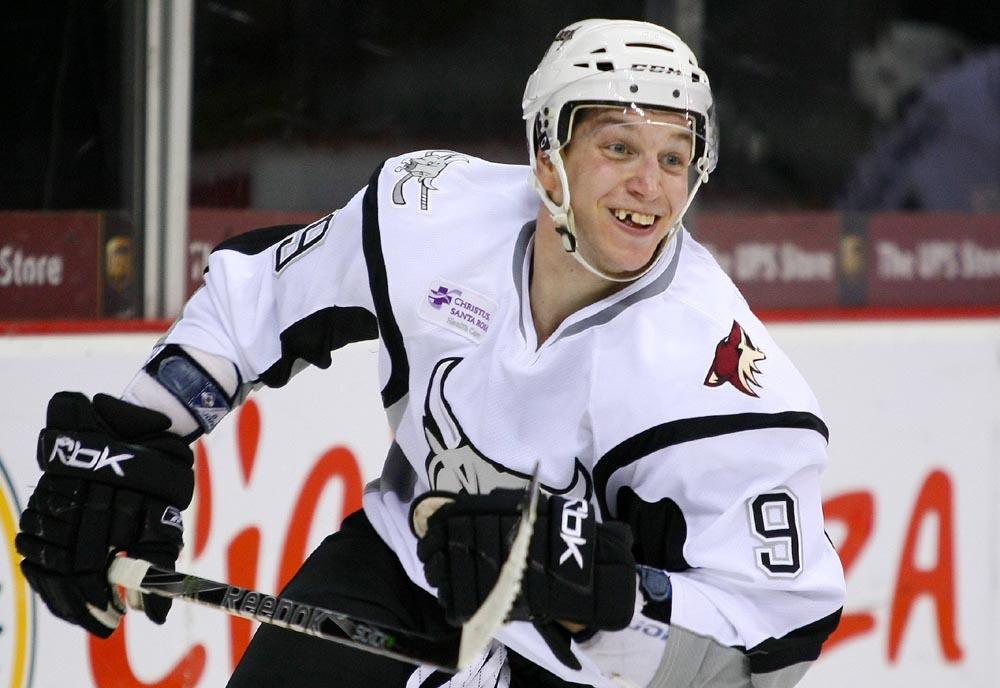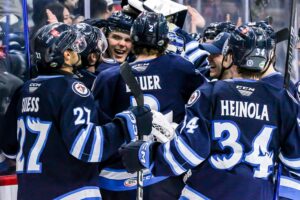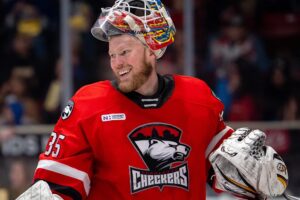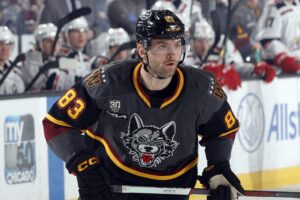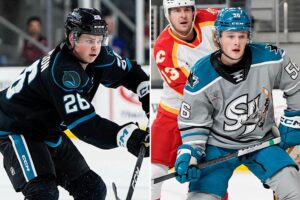by Jackie LaPenta || AHL On The Beat Archive
The image at the end of the season of the winning team holding up their coveted championship trophy is not picture perfect when it comes to the sport of hockey.
These athletes don’t fit the bill of what a champion looks like with the players more closely resembling cavemen as you can spot their toothless grin through the thick mass of their bushy, unkempt beards.
The culture of hockey has its own unique style that sets it apart from the other popular sports of North America. In a place where losing teeth and receiving stitches on the sideline doesn’t grant you a spot on the injured reserve list, there lies the obscure hockey traditions that bemuse fans with each passing season.
While the psychology of athletes is a different world compared to that of non-athletes, hockey players are notorious for relying on superstitions to play a big part of their mental preparation on game day.
“The Great One,” Wayne Gretzky, held a laundry list of odd game-day activities that he participated in which reflect some of the patterns held by San Antonio Rampage skaters. Gretzky had an order to which he put each article of his pads and uniform on which bears a resemblance to Rampage defenseman Nolan Yonkman’s dressing ritual.
“I always put on my left skate before my right skate,” said Yonkman. “The same thing goes for my pads, I always have to do the left one first.”
Rampage left wing Alexandre Picard also shares a similar superstition to Gretzky. Picard always has to shoot second during warmups; Gretzky made sure his first pregame shot was taken to the extreme right of the goal.
While not all players carry such exact phobias, they for the most part follow a routine to set them in a game-day mood.
“I try to follow a schedule,” said right wing Eric Neilson. “I always am sure to get a good breakfast first thing in the morning and then we have pregame skate. Chicken and pasta are pretty standard for a pregame meal, and then I like to get a nap in and lay down for an hour or two. The first thing I do when I get to the rink is make sure my sticks are done, and then I have the same warm-up routine I do before each game.”
A big part of a hockey player’s warm-up routine is oddly enough to play soccer.
“With soccer being such an international sport, it is something that everyone can play because it is in every country,” said San Antonio left wing Dane Byers. “We play a game called two-touch, it gets the mind thinking, the feet moving and builds team energy before the game that gets us talking and throws a little competition into the mix.”
No matter how much these guys practice their soccer skills, they will not be able to break the mold of hockey players which carries an unparalleled look about them as black eyes and crooked noses are the norm in the locker room.
However, the biggest attribute to their type is the number of missing teeth.
“The most common injury I see is broken or chipped teeth when dealing with hockey players,” said Dr. Roger Macias, who serves as the Rampage team dentist. “More severe injuries include teeth being completely knocked out or jaw fractures and contusions.”
Macias has been with the San Antonio Rampage for the last seven seasons and has also served as the oral doctor for the Spurs, Silver Stars and several intercollegiate and high school athletic teams in the San Antonio region.
“Fortunately in basketball, I have not seen any severe injuries, and while fly balls in baseball have been the culprit of knocking out teeth, hockey players have the more frequent and often worse oral injuries,” said Dr. Macias. “However, they are the nicest guys and some of the best patients to handle.”
“In hockey, it is rare for someone to not have lost a tooth,” said Picard. “In other sports, like football, they wear helmets to protect their mouth, but we do not have that.”
The Les Saules, Que., native is not bothered by having his front tooth missing after colliding with a goaltender’s helmet during training camp with the Anaheim Ducks. In fact, he is often caught flashing a grin displaying the gap in the middle of his smile.
“That has just become the look for me,” explained Picard. “While I am only missing that front tooth, I have had a root canal on just about every tooth on the top row from taking repeated pucks to the face.”
Yonkman’s tale of his missing teeth hits a little closer to home as he has had to befriend the foe who was responsible for the loss of his four front teeth.
“It actually happened when I was playing for the Milwaukee Admirals against San Antonio,” recalled Yonkman. “Brett MacLean shot the puck and hit me in the mouth knocking out my four front teeth. They are now set as one bridge.”
The worst damage Dr. Macias had encountered on the job with the Rampage was during the 2004-05 season when defenseman Filip Novak caught a puck in his mouth, ruining sections of both his upper and lower set of teeth.
“Most of the teeth were knocked out or chipped and he also managed to split his lip and tongue open in the ordeal,” recalled Dr. Macias. “After the incident, we squeegeed the ice in an attempt to find his missing teeth and while some were recovered, we were unable to repair all of them. That sticks out as one of the worst I have seen.”
Rampage fans might be shocked to know that enforcer Neilson has all of his teeth intact, aside from a slight chip.
Another physical distinction that not only sets apart the look of hockey players from other athletes, but also the traditions of the game, is the playoff beard.
It was originally introduced to the sports world in 1979 when tennis star Bjorn Borg grew out his beard before every Wimbledon and proceeded to win the competition five years in a row. The beard was brought into the hockey scene when the New York Islanders housed their dynasty team in the early 1980’s.
Ken Morrow, Butch Goring, John Tonelli, Clark Gillies and Gord Lane were the five Islanders credited with starting the fad as they grew out their thick, black beards during the 1980 NHL playoffs and won the Stanley Cup. They continued to do this in the following seasons and won four consecutive Stanley Cup Championships, which prompted the rest of the league to catch on to the good luck charm.
“It’s a great bonding tool to do something together as a team,” said Byers. “Some guys can grow great beards while others cannot, but it is a testament to how far you have gone in the playoffs.”
With each guy’s genetic make-up being different, it has become a game in itself to see who can grow the best beard as each season presents itself with a wide range of candidates.
“One year I dyed my beard and hair black,” said Neilson. “I wanted to look more warrior-like and intimidating.”
Other players do not have that option as they cannot grow facial hair in the same manner.
“I try to grow one every year,” said Picard. “I don’t really have a lot of facial hair so it takes me a bit longer than some of the other guys.”
Growing a playoff beard is not only meant for the guys on the ice, but also for the fans. It has become one of the oddities that fans participate in which helps strengthen their bond with the team.

































